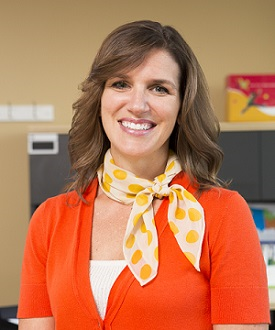Heather Hiebsch, principal at Poudre School District Global Academy, shares four lessons for creating a successful hybrid school
Several of our high schools in Poudre School District [1] (PSD), Fort Collins, Colo., serve more than 2,000 students each, and for the vast majority, these are positive places to learn and excel.
But there are also students whose needs are not met in a large, traditional school – students who, for a variety of reasons, need a smaller environment and more individualized attention to succeed. This is the story of a school that was created to serve these non-traditional students and the lessons we learned along the way.
Six years ago, our district created the PSD Global Academy, and I was hired to launch the school. Our charge was to provide students with online learning opportunities. We partnered with personalized learning solutions provider Aventa Learning – now Fuel Education [2] (FuelEd) – and started by serving a few high school students, primarily targeting dropout prevention and recovery.
Lesson 1: Students need to feel they belong somewhere
Soon, we saw that our students weren’t succeeding, but we knew they had much more potential than was showing in the data. These students weren’t completing their courses, and almost none of them returned the next year. While there were various reasons that students dropped out, we knew that one of the keys to engaging students in any kind of learning is to provide opportunities for affiliation with their school – something we weren’t doing well in a solely online environment. Learning exclusively online from home, they considered PSD Global Academy a temporary measure to get back on track, rather than “their school.”
To remedy students’ feelings of being unanchored, we secured a small modular building in the second year and hired a local school counselor. At that time, we shifted to a full K-12 school, hired local teachers and implemented a hybrid model of online and classroom learning. The next year, having outgrown our space, we moved into a former elementary school. We then expanded our offerings at PSD Global Academy, attracting a wide range of students, including those seeking accelerated courses. We also saw an influx of elementary students – including former homeschoolers – and secondary students looking for a smaller learning environment.
(Next page: Hybrid lessons 2-4)
Lesson 2: Achievement soars with a winning learning model
As we grew, we gave students the choice of strictly online courses or a hybrid schedule, where they could take online courses from home and attend classes on campus twice a week. In their days on campus, students would be involved in inquiry-based, hands-on projects – learning opportunities that are difficult to do online and/or from home. Our daily schedule also included more opportunities for special electives such as art, PE and music. We knew our hybrid learning format was an effective model, but we were amazed to see that the students who opted for it achieved significantly higher scores on state assessments – seven times higher than those who did not. At that point, we moved to an exclusively hybrid model.
We continue our partnership with FuelEd in providing online curriculum for all of our middle and high school courses, and use FuelEd’s partner, K-12, for our elementary student curriculum. Our own instructors teach the core online courses, so students are interacting with the same teachers whether they are learning at home or on campus. We also offer our secondary students a vast library of online electives, primarily taught by FuelEd instructors.
Lesson 3: A robust orientation paves the way
Along the way, we discovered the importance of a comprehensive orientation to set up students for success. We now spend the entire first week of school with orientation and training activities so students know what to expect and parents are prepared to be teaching partners (our at-home Learning Coaches). We have also taken steps to boost parent participation, including matching each new parent with a veteran parent mentor, and holding parent professional development classes.
Our teachers truly are pioneers (also our school mascot) in finding the best ways to serve our students in a hybrid learning model, and their innovation knows no bounds. For example, our four core high school teachers collaborated to build an advisory course about non-cognitive skills that students will need to succeed in school and in life. Our students benefit greatly from learning about developing grit, motivation, perseverance, a positive mindset and fostering healthy relationships.
Lesson 4: Focusing on your vision helps every student succeed
Today, we serve more than 150 full-time students each semester at PSD Global Academy, and we are seeing the results of our focus on individual student growth. Our school ranked among the highest in the state of Colorado for student growth across all grades for the 2013-14 school year in reading, writing and math. This achievement marks the first time a school using blended and online learning has ranked in the top five percent of all Colorado schools – including traditional brick-and-mortar schools, charter schools and other online schools.
Through our hybrid model, students have the best of both worlds. Online courses offer them flexibility and personalized learning, while the campus setting offers students support, community, and opportunities for hands-on learning.
The solution was in taking a global vision of how best to reach students in a nontraditional learning environment and implementing that vision in a very local way that would meet our students’ needs. Our teachers are poring over data, partnering with parents, and are truly committed to helping every student grow. Our students are engaged in learning and excelling in their classes.
In our hybrid setting, students are receiving the benefits of personalized online learning, academic interventions that connect school and home, and also enjoying the affiliation that comes with being part of a school community. Our kids are joining clubs, participating in student council, creating a yearbook, competing for spirit weeks and attending movie nights on campus. Students, staff and parents have worked hard to create an innovative learning community – and now PSD Global Academy is “our school.”
Heather Hiebsch is principal at Poudre School District Global Academy.

